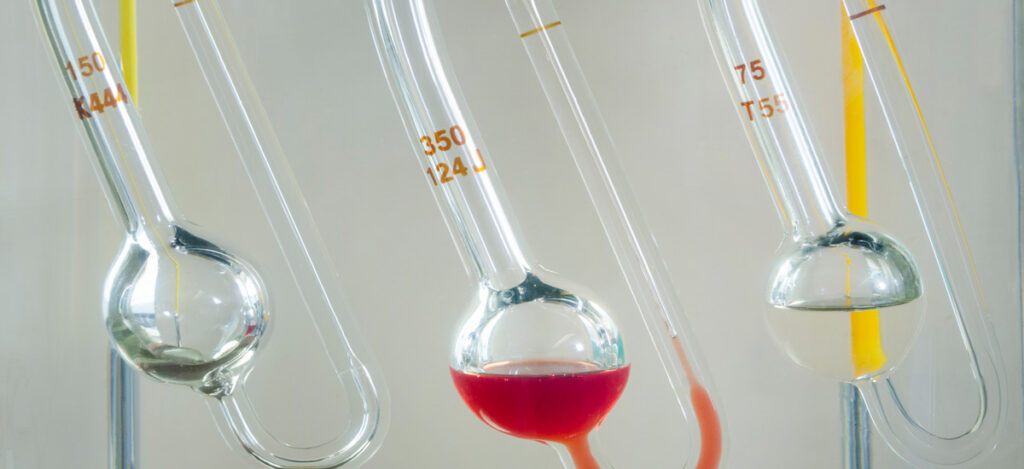What are the differences between capillary and rolling ball viscometers for calculating parenteral product viscosity?
What is viscous Friction?
Viscous friction (also known as viscosity) is the amount of internal friction (or internal resistance) between components in a fluid. Honey is an everyday example of a highly viscous product (viscous fluid). Products with high viscosity (alslo known as viscous liquids) are considered “thick” and flow slowly. In contrast to honey, water is an example of a fluid with low viscosity. Fluids, like water, with low viscosity are considered “thin” and flow quickly and easily. A fluid’s flow speed depends on how fast the molecules in a fluid can rearrange and move past each other. Thus, liquids with small molecules tend to have low viscosity. Liquids with long-chain molecules (such as hyaluronic acid) have higher viscosity. Also, liquids with molecules that can form bonds with each other are more viscous. The bonding of glucose and fructose in honey is why honey is so viscous.
What are viscous Fluids?
Viscous fluids often have high concentrations of large molecules or non-aqueous solvents. Highly viscous injectable formulations contain both. Examples of large molecules include monoclonal antibodies, proteoglycans, and high molecular weight polymers. Proteoglycans like hyaluronic acid are included in many cosmetic or parenteral products. Additionally, controlled release versions of parenteral formulations often include high molecular weight polymers. When it comes to non-aqueous solvents, oil-based product formulations tend to be the most viscous.
How is Viscous Friction calculated?
The United States Pharmacopeia offers three methods for viscosity determination. The first method is the viscosity-capillary viscometer approach (USP 911), which is the focus of this article. The second method is a rotational rheometer technique (USP 912). The rolling ball viscometer method (USP 913) is the third option for calculating viscosity.
What types of fluids do rolling ball and capillary viscometers assess?
Rolling ball and capillary viscometers are used to determine the viscosity of Newtonian fluids only. As viscosity depends on temperature, the temperature of the samples measured for both rolling ball and capillary viscometers should be controlled to within ±0.1°C when evaluated.
What methods are used for rolling ball viscometer vs. capillary viscometer calculations?
Rolling ball viscometer calculations are performed using rolling ball viscometers. Capillary viscometers calculations can be achieved by using suspended level (Ubbelohde) and Ostwald-type viscometers.
What are the differences between rolling ball viscometers and rotational rheology for Syringe Filling Calculations?
Rolling ball viscosity measurement is based on Stokes’s Law, where the tube of the rolling ball viscometer is considered a capillary. With Stoke’s Law, measuring a ball’s rolling time within an inclined cylindrical tube filled with the fluid under assessment can determine a liquid’s viscosity. The ball’s velocity is determined by measuring the time the ball takes to travel a fixed distance (i.e., the distance between two ring marks or measuring sensors). For each measured velocity (rolling time), the resulting viscosity can be expressed as dynamic viscosity (mPa x s) and kinematic viscosity (mm2/s) for a sample of known density. In contrast, capillary viscometers rely on knowledge of the density of the liquid and fluid flow time to determine kinematic viscosity. U-tube and suspended-level capillary viscometers work equally well to determine Newtonian fluid viscosity.

In terms of cost, rolling ball viscometers are about $3,500 for a basic benchtop model. Capillary viscometers range from $30,000 basic benchtop models to expensive $100,000 models most used for injection molding that measure the viscosity of material as it passes through an extruder.
Rolling ball systems are simple to use and involve filling the rolling ball viscometer tube with a sample and allowing the device to measure the time required for the ball to roll a fixed distance. The tube and ball combination is chosen based on the anticipate viscosity range of the fluid sample. Additionally, the tube’s inclination angle is selected based on an anticipated ball rolling time of at least twenty seconds. Capillary systems are also simple to use and involve filling the capillary viscometer tube with a sample and allowing the device to measure the time required for the liquid level to drop from one height to another.
Summary
Overall, viscous fluid formulations often have high concentrations of large molecules or non-aqueous solvents. With large protein biologics popularizing the drug therapy market, viscosity calculations for syringe filling and vial filling are essential for determining delivery mechanisms and accurately filling parenteral products. Rolling ball and capillary viscometers are two of three USP-approved ways to calculate viscosity. Both rolling ball and capillary viscometers only calculate viscosity for Newtonian fluids. Rolling ball viscometers uses one type of device, a rolling ball viscometer. In contrast, capillary viscometers come in two equally accurate devices, suspended level and U-shaped viscometers. Capillary viscometer devices are more expensive than rolling ball viscometers. Thus, consider using a rolling ball viscometer over a capillary viscometer device if a Newtonian fluid is being assessed and the cost is a factor. All in all, when filling a viscous parenteral or cosmetic product, ensure you choose a contract manufacturing organization to support your sterile filling needs.
MycoScience is a contract manufacturing organization specializing in sterile syringe and vial filling. MycoScience also offers Preservative Efficacy Testing, Sterilization Validations, Bioburden Testing, Cleaning Validations, Microbial Aerosol Challenge Testing, Accelerated Aging, Microbiology Testing, Cytotoxicity Testing, Bacterial Endotoxin Testing, EO Residual Testing, Package Integrity Testing & Environmental Monitoring services medical devices and allied industries. MycoScience is an ISO 13485 certified facility.
References
3B Scientific. Falling Sphere Viscometer. 2021.
Andrew Donnelly. Injecting High Viscosity Drugs: Challenges and Solutions. Bespak.com
Andy Fry. Injecting Highly Viscous Drugs. Pharmaceutical Technology. 2021.
IKA. ROTAVISC Viscometers.
Lilli Sherman. Rheometers: Which Type Is Right For You? Plastics Technology. 2004.
Michael J. Akers. Sterile Drug Products Formulation, Packaging, Manufacture, and Quality. Drugs and the Pharmaceutical Sciences. Informa Healthcare. 2010.
United States Pharmacopeial Convention. <911>. Viscosity- Capillary Methods. Rockville, MD, USA. 2021. (USPC <911>).
United States Pharmacopeial Convention. <913>. Viscosity- Rolling Ball Method. Rockville, MD, USA. 2021. (USPC <913>).
Sharing this in your social netwroks

